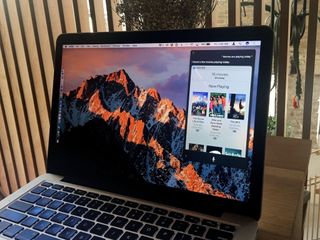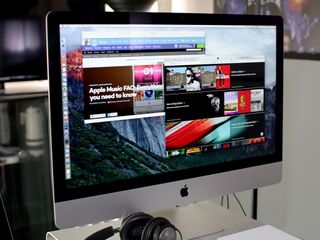So where are all the new Macs for 2016?

By this time last year, Apple had introduced the then all-new 12-inch MacBook, updated the 13-inch MacBook Pro, spec-bumped both the 11 and 13-inch MacBooks Air, updated the 15-inch MacBook Pro, and introduced a less expensive version of the 27-inch Retina 5K iMac. This year, all we've gotten so far is a spec-bumped 12-inch MacBook.
Let's be clear: I want new Macs as much as anyone. I didn't buy last year's MacBook Pro because I was waiting on this year's. I didn't buy the first-generation new Mac Pro because I was waiting on the second. (I ultimately went iMac because the wait was so long and the screen so pretty.) But this isn't a a complainer piece. This is a thought exercise. I've moved on through my stages of no-new-Mac grief, dodging acceptance, and into the realm of desperately trying to make sense of it all.
Now, we've had droughts when it's come to Apple product announcements before. Between iPad 3 and Apple Watch, we went a couple of years with no March event and sometimes no new announcements at all until WWDC in June. We did have a March event this year, and did get iPhone SE, the 9.7-inch iPad Pro, new Apple Watch bands, and the aforementioned MacBook update.
Last year, there were rumors we'd get the new Apple TV at WWDC in June but it ended up being shown off at the September and shipping in October instead. This year there were rumors we'd get the new MacBook Pro at WWDC, but it ended up being all about software instead. So what's the deal?
MacBooks Air
When Steve Jobs pulled the original MacBook Air from a manila envelope at Macworld 2008, it reset all expectations. The current 2011 design has been unabashedly adopted by almost every other manufacturer on the planet. It's become iconic. But it's also an icon that's reaching the end of the line.
The new MacBook has replaced the old MacBook Air as lightest laptop in Apple's lineup, just like the Air replaced the old MacBook. The Air exists now to fill Apple's "starting at $899" price point, much as the old MacBook did before it was retired.
Once the new MacBook — and it's Retina display — come down in price, the MacBook Air won't be long for this world.
Master your iPhone in minutes
iMore offers spot-on advice and guidance from our team of experts, with decades of Apple device experience to lean on. Learn more with iMore!
MacBook

Apple already bumped the 12-inch MacBook this year, taking it up to a current-generation Intel Skylake Core-M processor. Intel crippled the m3 enough that you can feel it struggle at times, but the m5, and especially the m7, are fast enough for any mainstream computing needs. The current MacBook is still aspirational, the way the original MacBook Air was, but it'll become everyday soon enough, just like the 2011 MacBook Air redesign did.
It'd be great if Apple introduced a 14-inch MacBook as well, setting it up as a full-on Air replacement. If that happens, it'll be when everything is in place to properly drive the bigger screen experience, even if the mainstream price points are still to come.
MacBooks Pro
Here's where things get interesting. Apple updated the 13-inch MacBook Pro back in March of 2015 with then-current generation Intel Broadwell processors. There were no chips appropriate for the 15-inch MacBook Pro at the time, so in May Apple updated it with previous-generation Haswell processors. A month later, Intel shipped those chips.
That's a stark reminder of how dependent Macs remain on Intel processor roadmaps — and sometimes the roadmaps of graphics processor vendors like AMD as well.
Intel has since introduced the next-generation Skylake, which Apple adopted it for the 12-inch MacBook in March of 2015, but hasn't updated either the 13-inch or 15-inch MacBooks Pro with it.
Microsoft did choose to go with Skylake for its SurfaceBook convertible, but it was plagued with issues, including a failure for the machines to sleep, which caused them to get incredibly hot in bags.
Like with the MacBooks Air, Apple's design for the Pro has been largely emulated by the industry at large, and merely bumping the specs to current generation chips isn't that interesting anymore. That's why rumors have included everything from OLED function rows, to Touch ID, to mics capable of handling "Hey, Siri!"
There was speculation an all-new MacBooks Pro would debut at WWDC in June. That'd make it easy to see why Apple wouldn't spec-bump the old design in March or May. (Can you imagine the reaction of those who bought spec-bumped MacBooks Pro only a month before all-new MacBooks Pro were launched? Yeah…)
If that plan was later changed, and the product demanded a big, public demo at launch, these days that would likely mean the fall. That's what happened with the Apple TV last year. It was scheduled for WWDC, then rescheduled, and that meant the fall event.
If that's what's happening here, and there will be new MacBooks Pro this fall, then that's still a long time between updates — Slightly longer even than the time between iPhone 4 in June of 2010 and iPhone 4s in October of 2011. And that's frustrating for people who simply want a spec-bump to get existing work done faster. But it's what happens when the technology being readied is more than just a spec bump.
iMac

For the last couple of years, the iMac has been updated in October. In 2014 that included the introduction of the 27-inch Retina 5K iMac. In 2015, the introduction of the 21.5-inch Retina 4K iMac and the update of both sizes to DCI-P3 wide-gamut color space.
The 27-inch model has current-generation Intel Skylake processors, though the 21.5-inch was introduced with previous-generation Broadwell processors. That's thanks to Intel not producing Skylake processors with the integrated Iris graphics appropriate for the 21.5 inch. How Apple addresses that this year will be interesting to see.
Either way, we'd likely not see iMac updates until later this fall anyway, and Intel's increasingly unpredictable roadmap makes it tough to know what, if anything, will be ready for iMac by then.
Mac mini
Apple's bring-your-own-mouse-and-keyboard Mac, the mini, hasn't been updated since 2014's unibody model. It's currently on Intel's two-generations-back Haswell architecture as well. There was no Broadwell update and, so far, there's been no Haswell update, much less Skylake.
Mac mini hasn't been on a yearly update cycle since 2012. It skipped 2013 and skipped 2015. It's never skipped two years, though, far as I can recall.
While beloved by Apple-centric home theater enthusiasts and those who want Mac servers at home, it's primarily positioned as the least expensive point of entry for Mac desktops. It's easy to think that probably makes it low on the attention list, but there could be more at play here, as well.
Mac Pro

The New Mac Pro was first shown off with "no longer innovating my ass" fanfare back at WWDC 2013 and it first started shipping at the end of the year. Since then, nothing.
Xeon chips are used in the Mac Pro, but Apple chose not to update when the Haswell versions were introduced. Apple has also chosen not to upgrade the graphics cards for the last few years either, which could, on a machine designed for OpenCL, have improved performance despite no GPU update.
It's possible Apple's been waiting on Xeon Broadwell or even Skylake to update. That'd be a long, long time between updates, though, especially for the high-end customers who want or need bleeding edge performance — the very customers Mac Pro is designed for.
So where are the new Macs?
Given how Apple typically operates, and the rumors surrounding this year's Mac lineup, here's the only scenario that currently makes sense to me:
- Apple didn't release spring updates for the MacBooks Pro because the company anticipated having the new MacBook Pro ready by summer.
- When the summer timeline no longer made sense, and given the update was big enough to benefit from a keynote debut, Apple reset for fall.
- Because of technologies coming with the new Macs, perhaps including a new display that worked with all of them, presenting them as a group would have the biggest impact (or all of them simply had to be set for the fall for similar reasons anyway).
- So, fall for everything.
That's all either possible, or so wrong it's making a bunch of product people laugh their collective innovating-my-asses off right now. Apple could ship them any time, of course, with or without an event. It just seems like if they're getting a big update, they'd get a big intro.
Either way, it's a question we're getting asked all the time these days, almost every day. I ran into one of my biggest heroes in the software industry a few weeks back and his first question was — "where's the new MacBook Pro?!"
It's a question Apple must be getting exponentially more as well, and one only the company can answer. And if history is any indicator, the company will only do that when they're ready.

Rene Ritchie is one of the most respected Apple analysts in the business, reaching a combined audience of over 40 million readers a month. His YouTube channel, Vector, has over 90 thousand subscribers and 14 million views and his podcasts, including Debug, have been downloaded over 20 million times. He also regularly co-hosts MacBreak Weekly for the TWiT network and co-hosted CES Live! and Talk Mobile. Based in Montreal, Rene is a former director of product marketing, web developer, and graphic designer. He's authored several books and appeared on numerous television and radio segments to discuss Apple and the technology industry. When not working, he likes to cook, grapple, and spend time with his friends and family.
Most Popular





